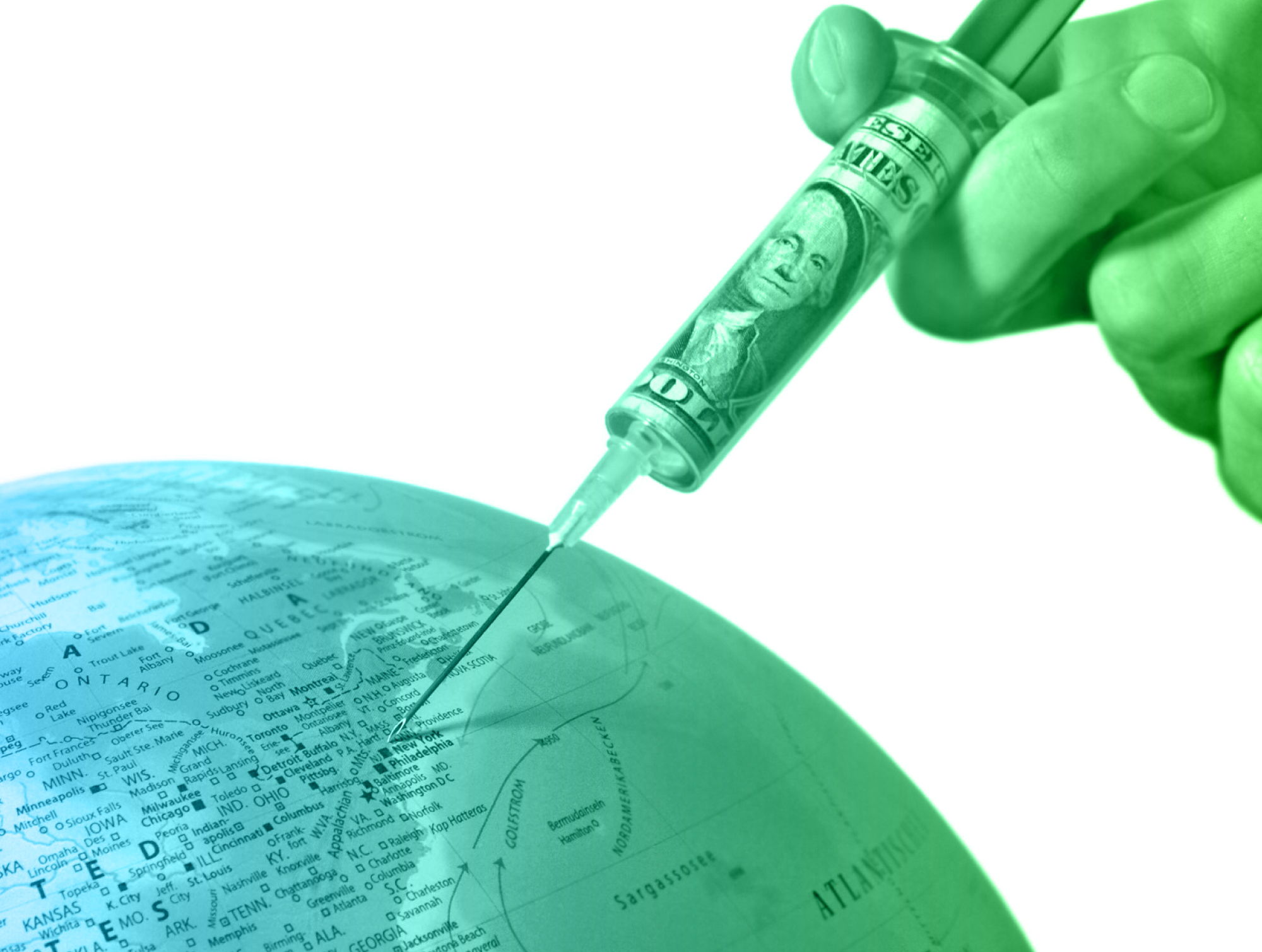December 2010: ‘Tis the season for looking ahead to next year, making “Top 10” lists of everything and reviewing the highlights and lowlights of the year just coming to an end. From currency wars to information wars, from natural disasters to geopolitical procrastinations, from e-commerce to m-commerce – in fact mobile everything – trends are (not always) slowly reshaping our lives and work. In September we published 10 Key Trends to Watch. In the first of our monthly briefings, let’s take a look at these trends in action – and the shape of what may be to come. But don’t sit back and relax – in action means you too! Get thinking! Get innovating – if you don’t, someone else will, maybe someone not even on your radar screen…
The Obligatory In-Flight Safety Briefing: A quick note to start – trends are just that, trends. They don’t start and stop according to the calendar and they certainly don’t deliver neat “answers” or outcomes. Some evolve over long periods, others move faster than anyone can anticipate, so don’t expect predications, expect food for thought. Your role is to ask questions like “what if”, “how could we do that”, “what industry am I really in”, “who can help us succeed” – and then to translate this into options, choices and actions you and your organization could take to succeed in this uncertain and complicated world around us. We offer some suggestions on this in our article Bringing Global Trends Alive in Your Organization Today. For now, let’s take off!
10 Key Trends to Watch – In Action!

1. The mobile time machine
Mobility is everywhere: resources, people, products and services, capital, knowledge, beliefs, opinions and more. Data has become a deluge, information can be “tweeted” globally in minutes, and an ever-expanding array of digital media competes for our time. As mobility expands, time is being compressed. Organizations able to manage the dynamics of this mobile time machine will have an advantage.
In Action!
Social media time spent: Over half a billion people are on Facebook and 200 million of them use it on their mobile phone. 175 million Twitter users tweet 95 million times a day (Sept. 2010) while 2 billion videos are watched daily on YouTube and 14 hours of video is uploaded to the site every minute. Time spent on social network and blogging sites is growing at over three times the rate of overall Internet growth, and Nielsen estimates that time spent on social networking sites (home and work) increased from 3.5 hours to 6 hours between March 2009 and March 2010. What did we use to spend our time on before – conversations, family, friends, work?
Wikileads/Wikileaks: Wikileads follows the online conversations about Wikileaks, the controversial “freedom of information” site which has leaked US diplomatic cables as well as inspiring an information “war.” While Wikileaks has compressed the time between when information is shared in the US government to when the public sees it (not necessarily legally), Wikileads is acting as an aggregator of the reactions to Wikileaks, allowing us to share in broader global reactions faster than if we had to hunt down the information alone.
Look Out For…
More organizations seeking “quiet time”: No email days have been around probably even 5 years as companies sought to help employees counter the daily deluge which impacts productivity – and build relationships face to face and through conversation. The idea of quiet time has been around since school days for many, and now is being extended in more and more companies, including IBM, Intel, U.S. Cellular and Deloitte & Touche, as the sources of information bombardment and interruptions increase (smartphones, internet, tablet PCs etc.). Some seek to regulate use of technology, some simply to not use it for a day. What will your organization do?
Tools to help people overwhelmed by choice and multitaskers: Research suggests that (a) too much choice tires the brain and results in poorer decisions, and (b) heavy media multitaskers do not pay attention, control their memory or switch from one job to another as well as those who prefer to complete one task at a time. While we already have some tools to help with choice, e.g. comparison websites, peer to peer recommendations and more, multitaskers have fewer apart from family pressure in the case of the millenials who have grown up multitasking. These issues will only increase as greater variety in products, services and digital channels increases, so look for some innovative solutions to help address the challenges potentially aided by advances in neuroscience.
More industry boundaries blurring: See trend 7 below.

2. Potential for crises in water, food and electricity
The world’s population is projected to reach 9.1 billion by 2050, from 6.9 billion today, placing significant strain on critical resources. For example, by 2030, the water gap could be as much as 40% between demand and supply, while the FAO suggests food prices will be structurally higher in future. The capital required to meet projected energy demand through to 2030 is estimated at US$1.1 trillion per year (or 1.4% of global GDP). Without widespread action to tackle these issues, geopolitical and social tensions may rise, along with negative economic impact.
In Action!
Nile treaty under pressure: The current Nile treaty allows Egypt to use 80% of the Nile’s water, Sudan to use 10% and the remaining 7 upstream countries to share the remaining 10%. However tensions are rising, after talks in 2010 between East African countries that control the sources of the Nile – without Egypt at the table. Kenya’s minister of water resources, Charity Ngilu, called the old treaty “obsolete and timeworn” and said Egypt and Sudan have “no choice” but to negotiate a reallocation of the Nile’s waters. 5 of the upstream countries have already signed an agreement to seek more water from the Nile, with the other two expected to join soon. While Cairo maintains that “Egypt will not join or sign any agreement that affects its share,” expect rapids ahead.
Rare earths: Recent geopolitical muscle-flexing over rare earths (REE) has highlighted major strategic vulnerabilities in the supply chains of dozens of countries and many more companies worldwide. REE are used in many clean technologies as well as high tech products. Tensions arose as China, which has an effective global monopoly on the production of these critical raw materials, appeared to be using this leverage in geopolitical disputes over disputed islands with Japan, and in currency and trade issues with the US and Europe. The episode highlights increasing tensions worldwide over control of and access to critical raw materials – issues that will keep increasing along with the growing population’s demands for resources.
Look out for…
Increased water-footprinting: As concerns over water rise, there will be increasing demand for companies and nations, as well as individuals, to understand how their patterns of consumption, production and living impact the supply of critical freshwater. While water remains an almost “free” resource worldwide, the price of water may well increase in future as shortages start to become more obvious. Organizations at the forefront of understanding their water footprint along their entire value chain, such as South African Breweries and Coca-Cola, have an advantage in starting to change consumption and production patterns – which can take significant time – to reduce their footprints. Expect more organizations and nations to focus on water footprinting in future as water scarcity risks rise.
A new steam age: Researchers are looking more closely at the promise of geothermal energy which could offer the potential to address the world’s energy problems. Heat from the earth is both clean and inexhaustible, with 99% of the earth estimated to have a temperature of more than 1,000oC. The challenge is reaching the heat and then harnessing it, as the technology is complicated and risks are high. A number of Norwegian organizations, including SINTEF are planning an ambitious project to capture geothermal energy from 5,500 metres deep in the earth’s crust – depths to which oil wells have already reached. The results of this project along with others could open the way for new forms of energy – as well as opportunities for oil companies to use existing expertise to tap into new sources of renewable energy, beyond fossil fuels. And don’t forget other alternative energy sources such as hydrogen and ammonia.
Africa – from windmills to nuclear power: Along with the rest of the world, Africa faces and energy challenge. While there are currently only two nuclear plants on the continent, both in South Africa, a number of African countries are looking towards nuclear power to help meet rising energy demand. Senegal, Algeria, Egypt, Ghana, Kenya, Morocco, Tunisia, and Uganda hope to have plants online by 2020, while South Africa is planning a further 6 nuclear plants. Nigeria is also investing in nuclear technology, with proposed assistance from Iran announced in 2008, which may raise some concerns globally. While the continent is rich in uranium, technical assistance from nuclear powers such as France, China and Japan will be needed to make Africa’s nuclear ambitions a reality.

3. The global technology race
Technology offers potential solutions for many of the world’s pressing problems, the key questions being “when” and “who” will deliver them. The race is on for leadership in critical technologies including nanotechnology and biotechnology, as well as applied technologies that address global issues such as health/ageing and resource challenges. Expect BRIC economies to be at the forefront along with industrial nations.
In Action!
Graphene: University of Manchester physicists Andre Geim and Konstantin Novoselov shared the 2010 Nobel Physics Prize for their ground-breaking work on graphene, a single-atom-thick sheet of carbon, consisting of carbon atoms held together in a honeycomb structure. Graphene boasts extraordinary properties that could transform electronics, vehicles, aerospace, food packaging and potentially any other industry you care to name. This wonder material is the strongest material ever discovered, yet flexible, extraordinarily light and transparent and could dramatically change the designs and materials used in industries such as aerospace and automotive. It also offers electrical conductivity 100 times greater than silicon, while giving off barely any heat, suggesting the potential for radical changes in computer chips and integrated circuits, which could become orders of magnitude smaller and more powerful. The potential of this new material is enormous – how could graphene change your world?
Medical advances: The practical application of robots in surgery is becoming more widespread and more accepted, with the medical robotic equipment market expected to growing substantially in the next few years. Robots have been used to assist in many types of surgeries from coronary bypasses to kidney transplants. On the horizon is the use of robots in bioprinting to produce functional human tissue (and potentially organs in future decades) to treat disease and accident sufferers, as well as for pharmaceutical research. Along with controversial advances in stem cell research, the effects of such medical advances could be far-reaching particularly for patients suffering from currently incurable conditions. Already some of these patients are becoming medical tourists to try to benefit from new, often highly risky treatments – and this trend is likely to continue.
Look out for…
Commercial space travel: in October 2010 the runway was dedicated at Virgin Galatic’s spaceport in the New Mexico desert, the first commercial spaceport in the world, taking the nearly 400 budding private astronauts one step closer to realizing their dream. Virgin hopes to make its first sub-orbital commercial space flights at the end of 2011 or in 2012. While the company is quiet on the subject there is also speculation that it may later extends its sights to orbital flight as governments increasingly with commercial partners in extending space opportunities, e.g. in serving the International Space Station. Meanwhile South Africa is also eyeing the potential for spaceports.
In fact, a whole new space race: China and India have already publicized their lunar ambitions, while a Japanese government panel in May 2010 outlined an ambitious project for JAXA (Japan’s space agency) to put humanoid robots on the moon by 2015. As part of the US$ 2.2 billion project, the robots would construct an unmanned lunar base by 2020, for exploration of the solar system. Given Japan’s financial challenges we shall need to wait to see how the plan evolves, but there is no doubt the potential for a whole new space race – especially as the moon offers the potential of resources of which the Earth is running short.

4. Competing in the BRIC—and beyond
Economic power is shifting inexorably to BRIC, and will continue to do so. These countries will account for the majority of foreseeable economic growth and the emerging global middle class. But the playing field in BRIC is getting crowded. It is time to look towards the next tier of attractive future markets, which are likely to include: Indonesia, Mexico, Turkey, Iran, South Korea, Egypt, South Africa, Thailand, Vietnam, Pakistan, Bangladesh, the Philippines and Argentina. With BRIC companies already actively moving there, firms from advanced economies need to expand their focus.
In Action!
Africa rising: In the first decade of the new century, Africa shook off its sluggish growth of the previous two decades and grew GDP at almost 5% per annum from 2000 to 2008. Africa’s collective GDP, at $1.6 trillion in 2008, is now roughly equal to Brazil’s or Russia’s. Part of this growth has been driven by rising prices of the raw materials in which the continent is rich, but the more important factors include internal structural reforms to improve the economic environment and end conflicts, plus managing inflation and debts down. African governments have also increasingly embraced the private business sector, through privatizations, attractive corporate tax rates, upgrading infrastructure and improving global economic relationships. Finally, the mobile phone has revolutionized Africa, with 400 million subscribers in 2009 versus practically none in 2000. This revolution has enhanced business opportunities, strengthened civil society and allowed new consumers to enter markets. Looking ahead, the underpinnings of Africa’s rise appear strong and, while always susceptible to conflicts and disasters, it is likely that Africa will play an increasing role on the world stage in future.
The emerging global middle class: In July 2010, a McKinsey article suggested that the purchasing power of the world’s emerging middle class totalled some US$6.9 trillion annually, and would rise to US$20 trillion by 2020 or about twice the current consumption in the US. This highly attractive group is found both in the BRIC countries and well beyond, with recent evidence suggesting that countries such as Indonesia and Vietnam are seeing rapid middle class growth. Indonesia’s economy is projected to grow over 6% in 2010 and 2011, with per capita GDP increasing up to 20% in the next two years, aided by abundant natural resources, manufacturing sector growth and a free trade agreement with China. Vietnam also has a rapidly growing economy and booming consumer markets. Vietnamese government estimates suggest that retail sales reached US$39.1 billion in 2009—almost twice as high as five years earlier. The challenge for companies seeking to tap into such growth is to strike a balance between focusing on developed economies, BRIC and the next group of highly attractive markets.
Look out for…
BRIC nations and beyond playing a greater role on the global stage: Recently nominated World Cup football nations Russia and Qatar will solidify and take their place respectively among nations hosting global sports events, following South Africa. China, Brazil and India along with Russia and other RDEs will have a greater voice in global geopolitical and economic affairs through the G20. They will also be key drivers in global economic growth in the next decade and more, as well as being home to the growing middle class, so expect to see the continued rise of global businesses from these nations.
RDE consumer trends and business models impacting global markets: It used to be that trends from the developed world were exported to RDEs, albeit adapted to lower purchasing power and different resource availability. Now, as RDE companies become increasingly powerful and global, we should expect to see more trends originating in these markets being translated the other way. Think computers for less than US$100, microfinance in the United States, low cost domestic appliances, solar-powered lights, and water purifiers to tackle polluted water and remove the need for bottled water. Consider the UK£5,000 Dacia Logan (Dacia is a subsidiary of Renault), manufactured for the Romanian market which became a hit in France, Germany and the UK. Or think about the Aravind Eye Care System in India which has pioneered specialized, low cost eye treatments reaching over 2.5 million outpatients and performing 300,000 surgeries in the year to March 2010. And it’s stunningly effective compared to developed world facilities in terms of success rates – how long before we see similar models in the developed world?

5. Growing influence of “we and me” not just “they”
The last twenty years have seen the emancipation of influence. People worldwide have seen their ability to make choices increase beyond imagination. Communications advances and increased democratization have allowed people find their voices. The power of “me” has been amplified through communities of choice, including social networks and buying groups, which are changing how we interact and behave. In this new world, trust and dialogue is critical to building and maintaining relationships.
In Action!
The increasing role of word of mouth recommendations: Communications are no longer one way. If your brand or company is seriously aiming to sell, you need to engage in a two-way dialogue with your customers/consumers – listening as well as talking. Word of mouth is an increasingly critical element in sales – in fact, it is the primary factor behind 20% to 50% of all purchasing decisions, according to a 2010 McKinsey survey. Think TripAdvisor in travel, or Facebook communities, or The Motley Fool in the financial space. But it’s an element that marketers cannot control. Instead they need to understand not only the consumer, but the networks around segments and how influence moves across these networks.
The rise of the blogosphere and twitterati: Social media are becoming much more influential in deciding which stories are news. Often, they are more up to date than mainstream media in terms of stories of interest to their audiences. Individuals also have greater power than ever before to get their voices heard. In fact, there is an emerging generation of new “stars” in the social media world from Arianna Huffington to Evan Williams joining the ranks of shapers and influencers globally. Through blogs and twitter posts, they have an increasing influence on what is news on topics including politics, foreign events, science, technology and health and medicine. Companies (and governments and societies) can afford to ignore these voices at their peril, because the reach of me and we is both vast and growing.
Look out for…
More and more co-creation: Consumers are exercising their choice and power by demanding more involvement in and customization of experiences and products, beyond the traditional “pull” and “push” approaches to marketing products and services. This new level of involvement is giving rise to the phenomenon of co-creation and customer made. Examples include Design By Me from Lego, where consumers design their own original custom LEGO model, and then purchase all of the bricks and elements to build it. Or look at Dell’s Ideastorm which involves online brainstorm sessions allowing customers to share ideas and collaborate with one another and Dell. Or Proctor & Gamble’s Connect & Develop Open Innovation program which involves consumers as well as many other external stakeholders in innovation. With consumers increasingly expecting and demanding involvement in products and services, along with ever-more personalization, expect to see many companies pushing further and faster along the co-creation path.
Advertising going tribal: The majority of U.S. consumers (83%) still cite TV advertising as one of the top three media having the most impact on their buying decisions. (Source: Deloitte). But things are changing, particularly among the more digital generations. 17% of people in Deloitte’s survey agreed strongly/somewhat that advertising/product placements in video games influenced their buying decisions more than any type of online advertising – and a similar number said advertising in social media had an influence. Over 20% said they would provide personal information and/or have their web browsing tracked to receive more personalized ads. At the same time the influence of online advertising appears to be falling, despite the fact that increasing numbers of people are learning about products online. What people are looking for instead is online recommendations whether to visit websites or about purchase decisions. In this new world of advertising and influence, appealing to “tribes” and working through communities will be increasingly important.

6. The rise of new power brokers
New power brokers are increasing their influence on the world stage, from the BRIC economies to social networks to the G20. New financial power brokers with vast assets will impact corporate governance and industries. Together, these new power brokers will shape global economic, political and social development. The age of the “superpower” is giving way to an age of multiple power brokers.
In Action!
Oops! We mortgaged the economy: In September 2010, China owned US$ 882.5 billion of US Treasury securities according to the US government, around 10% of the US Treasuries outstanding. Japan’s holdings are similar, with the UK holding around half as much US debt. Overall the IMF estimates that gross government debt (Treasuries + other debts) in the US accounted for some 93% of GDP in 2010. It’s not alone in seeing massive increases in debt, partly due to the financial crisis. The IMF suggests the debt burden among advanced economies will rise to 114% of GDP by 2014 versus 75% in 2007. Casualties of this rise in sovereign debt are already being counted as first Greece and now Ireland had to resort to bail-outs from the IMF and fellow Eurozone members. Other economies are also on the at risk register. While key concerns with these debt increases are the future burden of taxpayers as well as the impact of reduced spending on public services, another is the potential future impact/demands of the new financial brokers who are either holding sovereign debt and/or assisting economies in trouble.
Increasing influence of sovereign wealth funds: After dramatic growth since the 1990s, sovereign wealth funds (SWFs) saw their assets significantly damaged by the crisis, falling from US$ 3.9 trillion in September 2008 to US$ 3.5 trillion in March 2009. With some 60% of SWFs dependant on petro-dollars, falling oil prices also hurt income streams. However, they are showing signs of rebounding with the SWF institute estimating market size at US$ 3.8 trillion in March 2010. Looking forward, the influence of SWFs is expected to grow significantly – although transparency will continue to be a major issue. The focus of investment also remains to be seen long-term, as caution has reigned in 2009 investments, with many more at home than in previous years when around 80% of investments were overseas. The continued creation of sovereign wealth enterprises (SWEs) gives SWFs more flexibility in investments – and potentially lower scrutiny. Also look out for increasing links between SWFs and private equity.
Look out for…
Increasing south-south investment flows, with a focus on securing natural resources: South-south investment has been growing as foreign direct investment (FDI) outflows from RDEs have increased rapidly in the last decade. Securing access to natural resources has been a key driver, for example large Chinese and now Indiian investments in African countries. UNCTAD suggests that increases in South-South investment in agricultural production will continue in the long term, with investors from developing countries becoming major sources of cross-border M&A. In 2008, their net cross-border M&A purchases, amounted to US$1,577 million, over 40% of the world total (US$3,563 million) and this is set to continue. Beyond commercial focus, food security is becoming an additional driver of investments, with governments and state-owned entities, particularly in Asia and the Middle East, becoming more involved and Africa emerging as the leading recipient of such FDI. However, there are potential future tensions from these new investments between cash-rich and food-poor nations.
Rethinking capitalism: The financial crash and economic recession of 2008/9 has called into question fundamental beliefs underpinning current Western free market capitalism, in particular the efficient markets theory, which formed the foundation of financial markets and their regulation for the last 50 years or more. With over 80% of people in a recent BBC/Globescan poll suggesting change was needed – and almost a quarter saying that a completely new system was required. Rethinking capitalism will be neither quick nor easy, and will likely involve various balancing acts between theory and practice as well as social, economic and financial considerations. The one certainty is that businesses will have to be flexible and forward-thinking enough to operate effectively in multiple different environments.

7. Interdependence and competition across industries, not just within
Industry boundaries are blurring and so are those of the organizations that compete in them. Value spaces are increasingly being defined by consumers, not firms. Take health and wellness – in the consumer’s mind this extends well beyond pharmaceuticals and doctors to food, fitness, beauty, online services and more. As boundaries blur and everything becomes mobile, players are increasingly interdependent. This extends to interactions with society, where new forms of networks and smart partnerships are emerging, to deliver commercial and societal benefits simultaneously.
In Action!
The democratization of personal finance: In a world where free market capitalism is under fire, bank liquidity difficulties continue, and the public has lost trust in the traditional financial services industry, the world of personal finance is undergoing a radical shift. The democratization of personal finance is gathering pace, redefining the boundaries of personal finance and creating a landscape where the “old” banking rules no longer apply. Only 2% of potential U.S. microfinance customers are being served compared to the 17% being served in the developing world. The “great unbanked,” more than half the world’s adult population, offer significant opportunities, including the 30% of Americans who have no banking relationship whatsoever. Look out for retailers, telcos and brands with high trust to emerge as new players in the personal finance value space. Consumers are taking control of their own personal finance value spaces. In this emerging “democracy” there will be many voices and many players competing to create and capture value.
The breaking down – or breaking out – of the music industry: Think about the music industry and how you enjoy music. Ask yourself ask some simple questions. First who is having a bigger impact on the development, growth and profitability of the industry: (a) a record label company focusing on “owning” artists and their content, (b) a mobile device company (e.g., a cell phone producer such as Apple) who is focusing on enhancing your lifestyle through the device—competing for “share of eyes and ears”—that provides an expanding array of services and applications, or (c) a software platform related company (i.e. YouTube, Facebook, etc) that doesn’t care about the device but rather is competing for being your platform for connecting and interacting with the world? For the music industry, is it more important to focus on competition within record label companies or to look at emerging patterns of competition across content, device, platform and maybe other players? Where would you invest in this industry?
Look out for…
Your industry next? Where are your industry boundaries blurring?
Look out for:
- More special reports on the evolving shape of industries in the New Year.
- Tools you can use in our forthcoming article Bringing Global Trends Alive in Your Organization Today.

8. Fight to own the new consumer
The fight is on to own the new consumer – a consumer that wants more involvement and personalization; that wants it all anywhere, anytime, and wants it to be cheap and chic as the climate of frugality bites. Businesses at all points in the value chain are trying to connect with the consumer to build reputations, trust, loyalty, returns, market position and ultimately the license to compete. As consumers increasingly demand experiences and solutions, this fight may evolve into new, creative forms of cooperation between firms and others.
In Action!
Amazon Undercover: Amazon’s new Price Check app allows shoppers to bring Amazon along to the bricks+mortar players, where the shopper can take a picture of the item they are interested in, scan a bar code or even say the name. The app then let’s Amazon instantly tell the consumer what similar products are available on Amazon and at what price. The best thing for those who don’t want to wait in line and carry the big purchases home is – it’s just one click to buy on Amazon. Similar apps are available for Android and other smartphones, offering broader price comparisons than Amazon, with one ShopSavvy, boasting 2.15 million downloads of the app in November 2010. For bricks+mortar retailers: Time to get involved in m-commerce.
Location-based services: Facebook launched its Places service in August 2010 allowing it’s more than half a billion user to signal their current location. Consumers can use the service to receive location-based offerings from retailers for products, services and more. They can get instant information on potential purchases from their friends or access reviews and see what is on offer nearby. Companies such as Best Buy, Macy’s, Sears and Walmart are already tapping into the potential, staying with their consumers wherever they go and whenever they want. This builds on initiatives of other online giants such as Google, which in December 2009 announced a “Favorite Places on Google” initiative that lets business owners place a barcode, or QR code, on their storefronts. Passerby and customers can then scan that code with their iPhone, Android device, or BlackBerry in order to receive information such as menus or a coupon. What could such services do for your business?
Look out for…
More companies trying to create captive markets: Apple is the poster-child of captive markets. With its iTunes service still dominating the music download market, it has expanded into the creation of hundreds of thousands of smartphone (iPhone) apps, streaming media and educational offerings through iTunesU. Apple has a vast and loyal user base which it can leverage across a broadening range of products and services – because its portfolio is broad, easy to use and innovative. Building such a customer base requires deep understanding of what matters to consumers, smart use of technology and a willingness to innovate not only in products and services, but around the business model to generate revenues from a whole range of ancillary products and services. Companies like Apple that can create captive (and willingly captive) markets have a huge advantage – and more companies will be trying to emulate this type of approach in future. How can your organization create such markets?
More innovative partnerships to reach key communities: UNESCO and World Heritage reached a partnership agreement with leading online travel advisory site TripAdvisor in 2010 to work together to promote awareness of the need to protect World Heritage Sites around the world. TripAdvisor aims to engage its large and passionate community of 25 million monthly visitors to help in several ways: (i) Encourage the contribution of reviews and opinions from its members to provide information about the condition of nearly 900 World Heritage sites so that these may be better protected; (ii) Ask travelers to vote on the places they want to protect most, and encourage donations to help conserve and support sustainable and responsible tourism. This innovative approach highlights new ways to reach important audiences – often communities – and the influence of the companies which have created such significant user bases. Expect to see more such creative ways of cooperating in future, particularly in the area of social good which is an increasing focus for many consumers.

9. Generational gaps
For the first time, four distinct generations are present in the workforce in many developed countries. The resulting differences in generational ambitions, attitudes, technology skills and ethics are impacting management styles, how work is done and the ability to attract talent. Such differences are also playing out in developing economies, with indications that traits and values are becoming more similar within generations across borders, than between generations within a region. Generational gaps will demand more flexibility in work, markets and societies.
In Action!
Differences in motivators at work: What motivates Generation Y at work is somewhat different from what motivates older generations, including baby boomers. A survey by the Center for Work-Life Policy suggests that the biggest area of difference between these two generations in terms of work motivation is in the area of recognition from the boss: This was important to 93% of Generation Y versus 82% of baby boomers. Generation Y also wants a much broader range of experience (important to 92% versus 85% baby boomers). Generation Y also puts slightly more importance on flexible work arrangements, high quality teams and the ability to give back to society through the job. As more of Generation Y joins and progresses in the workforce, these motivators will become increasingly important differentiators among employers competing for talent.
Increasing inter-generational conflict in the workplace: Differences in generational ambitions, attitudes, technology skills and ethics are impacting management styles, how work is done and the ability to attract talent. In many cases, because these differences remain unspoken and unaddressed there is increasing conflict between generations in the workplace. A 2009 Kelly Services study suggests that inter-generational conflict is found in workplaces across the world with over a third (42%) respondents experiencing such conflicts depending. Over 70% of respondents adapt their communications styles to communicate with colleagues from a different generation to avoid problems.
Look out for…
Focus on creating the next generation of leaders: Deloitte’s 2020 Talent survey, published in December 2010, asked executives what talent concerns would be among the most important in the next three years. Faced with an impending bulge of baby boomer retirements, 38% listed developing leaders and succession planning, narrowing this down to their single most pressing issue, which was leadership development. 71% of respondents expect to increase the focus on developing high-potential employees and emerging leaders in the next three years. The biggest challenges in developing this next generation of leaders will be for companies to recognize how the different generational characteristics will impact recruitment and engagement of talent, plus finding creative ways to turn the potential for inter-generational conflict into positive use of diversity.
Coming to a social network near you, soon: In the age of social media, organizations have recognized that they need to engage actively with these new sources of talent search, information and dialogue. This is where their target recruits will spend much of their time and have the benefit of advice and recommendations from their chosen peer networks. Many companies and recruiters have already started using professional networks such as LinkedIn actively, and are starting to ramp up their activities across broader social media including Facebook, YouTube, Twitter and more. Expect recruitment to continue to become more social media focused very soon – and companies, remember that such networks can be powerful sources of recommendation and review of activities, so plan well.

10. Tensions of globalization AND fragmentation
Even as the tide of globalization and integration continues, there is a growing and opposing trend towards greater fragmentation where tribalism, nationalism and cultural conflict is on the rise. Even cyberspace is under threat of fragmentation, as governments increasingly seek to erect national boundaries to block or monitor content, and technology providers develop proprietary “clouds.” How the potentially competing forces of globalization and fragmentation interact will have a significant impact on the economic, social and political development of the 21st century.
In Action!
Failures of global forums: The G20 summit in Seoul in November 2010 yielded little of interest in the way of decisions and actions. Now that the recession has eased, the urgency for continued co-operation has been replaced by increasing efforts to keep domestic economies on the road to recovery. However, growing domestic economies is tough when the big consumer markets of the US and Europe remain constrained in terms of spending power because recovery is slow and fragile – a situation which has led to trade tensions and talk of currency wars. Without shared understanding – and even more importantly ambition – to tackle the root causes of global challenges, economic and beyond, there is a prospect of a continued series of unilateral actions which may have unintended and unwanted consequences at the debating table and more importantly in the real world. A similar weakening of shared global ambition played out at the most recent Cancún climate talks, which again yielded little progress as the agendas of rich and poor nations remained apart, loopholes were left in and dates were left out. The world remains without united leadership.
Infowars, the Wikileaks fall-out: Whatever you believe about the leaking of US diplomatic cables by Wikileaks, the ongoing saga has brought into the public domain what many commentators have been speculating on and security experts fearing: Infowars. One question we asked ourselves at the very start of the leaking campaign was, Can Wikileaks be shut down? Clearly the answer is no – despite the best efforts of the US government, the Wikileaks organization has employed highly sophisticated technology as well as operating in multiple legal jurisdictions, which means for better or worse, the information leaks cannot be stopped. While this may be a positive in the case of free speech, it also has significant downsides if information sources have malign intentions. The other disturbing aspects of the current situation are the apparent threats to company information, the threat to deploy Wikileaks’ information equivalent of a thermo-nuclear device, the activation of nameless and growing groups of hackers through social networks, and the cyber-attacks both on Wikileaks and on companies which have chosen to withhold services from the organization. More recently, a faction is splitting off from the main Wikileaks organization to open OpenLeaks. If all this was happening in a military context, it would be clear that a war was going on – there is, it’s just an Infowar, but one that will have profound implications for all of us.
Look out for…
Internal interests diverting external focus: One of the big challenges in tackling global issues is first getting key nations to take an interest, even before trying to forge agreements and solutions. This looks likely to be an increasing challenge, not only in the developed world but also among rapidly developing economies, as internal regional/factional self-interests divert the energy and focus of governments. Take the increasing in-fighting between the US Republicans and Democrats, which is taking time and effort away from addressing global challenges such as trade and climate; or the ongoing sovereign debt woes in Europe which are straining relationships in the region and worldwide. In RDEs, there are also internal tensions, for example as protests and discussions continue over the carving out of a new state of Telengana in India, which would include software hub Hyderabad, home to companies such as Microsoft and Google in India; or as China continues to deal with relations with Tibet and Taiwan, as well as central-regional relations and the potential for social unrest.
Our changing relationship with the internet: In the wake of Wikileaks on top of a global catalogue of careless and criminal releases of confidential information, our relationship with the internet may start to subtly change. From a window on the world, a vital source of communications and communities, many are evaluating the potential downsides of a world-wide web where information can never be suppressed, and where communities can turn on their makers. From governments to companies to individuals, it is clear we need to think through what transparency really means, as well as the appropriate balance between openness and confidentiality. Expect also to see governments such as the US and China tackling the paradox of cyber-security, as it becomes increasingly clear that this is a double-edged sword. Mobilizing internet communities and capabilities for security reasons will be a necessary part of future national (and international) defenses, but there are always risks that the hackers get hacked by their own communities. Trust and integrity will become increasingly important tools in the new age of cyber-relations and cyber-threats.
UPDATE: New presentation of 10 Key Trends to Watch In Action! View and download it by clicking on the PDF icon.
In Future GT Briefings: Look out for trends in action in the areas of social good, m-commerce and infowars.
Happy Holidays and New Year from the GT Team!




